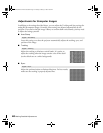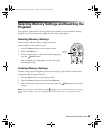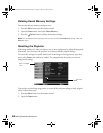
38 Making Detailed Adjustments
■ Motion Detection
This setting specifies how signals are converted to progressive signals. Select a lower
setting for slow-moving or still images (
S) or select a higher number for video images
(
M).
Note: This setting applies only when viewing composite video, S-video, component video, or
480i or 575i RGB video.
■ Noise Reduction
This setting reduces flickering of analog images. You can select from 3 levels of noise
reduction.
Color Settings
If the image colors don’t look correct, you can adjust them using these settings. Use the first
three settings described below to make the most visible changes. If you only need to make
slight adjustments, you can fine-tune the picture with the remaining settings. Most color
settings are stored separately for each image source and color mode.
■ Color Saturation
Adjusts the color intensity of the image.
■ Tint
Shifts the color balance between magenta and green.
■ Abs. Color Temp.
Shifts the color balance between red and blue, making the image appear warmer or
cooler. You can also access this setting by pressing the
ColorTemp. button on the remote
control. See page 30 for more information.
Signal > Motion Detection
Signal > Noise Reduction
Image > Color Saturation
Image > Tint
Image > Abs. Color Temp.
PowerLite Home Cinema 1080.book Page 38 Tuesday, February 5, 2008 4:46 PM


















